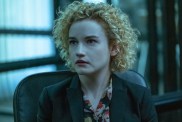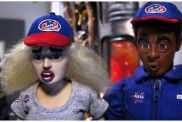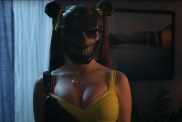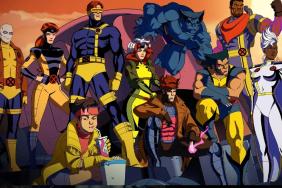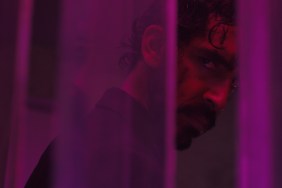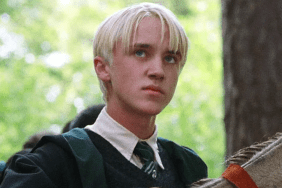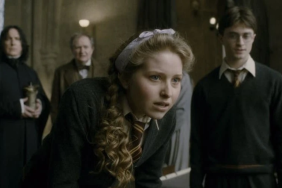Ever wonder how the magical and enchanting world of “Harry Potter” comes alive? We did too, so we didn’t hesitate when we had the chance to talk to six-time Academy Award nominee and three-time winning production designer Stuart Craig about Harry Potter and the Order of the Phoenix.
ComingSoon.net: About the Ministry of Magic, how did you find the inspiration for it, how much relates to the book, how much of it is your own thing?
Stuart Craig: I think it’s pretty faithful to the book. She is legendary for her description and the wealth of detail in her description, Jo Rowling, and so we have tried to keep faithful to all of that. As to inspiration, we went to research and asked ourselves “what do real underground places look like?” The most obvious one is the London Underground. We looked at some of the earlier ones, the ones built around 1900. It’s absolutely beautiful. They tried to imitate classical architecture but they used ceramic tile. That’s a hell of a good idea. It’s beautiful and impervious to water. That was one decision there and then. In places we gilded it so it’s burnished gold on top of the Victorian colors, the dark red and dark green. Another influence was a Burger King. If you look above the Burger King, there’s a fantastic Victorian façade which just embodies the age, decoration for decoration’s sake. The form of it is beautiful too, it has this bay window.
CS: How big is it?
Craig: It’s a Ministry; it’s the whole government of the magical world. The shots that immediately proceed it are in Whitehall in the seat of real Muggle government. Then, as you know, they enter the phone box and go down into this underground world, the magical ministry. They are parallel universes.
CS: How long did it take to make that set?
Craig: We did it in a fairly low key way. It probably represents 20 weeks of full-time construction.
CS: Is it the largest set you built for the films?
Craig: I think it is, yes. The most expensive.
CS: How big is it?
Craig: It’s in excess of 220 feet in length, it’s extended via computer generation which quadruples what you see on film. It’s as high as this stage will allow us. This isn’t a movie studio, so here we have only about 30 feet of working height, in a real studio you could have 45-50 feet.
CS: The statue in the fountain of the Ministry of Magic, is that an actual statue or will it be CGI?
Craig: Well, actually, there’s a wizarding family there, there’s a witch and a wizard, an ascentor, and a house elf, and a goblin. Four of those are physical and on our sets. The fifth one, the wizard, is in the CG part of the universe. So he is computer generated, the other four characters are real.
CS: Do you have other major new sets for the film?
Craig: The Ministry has many parts. There’s that huge concourse which we first see with everybody, it’s just like Waterloo station at 8:00 in the morning, with everybody sort of trotting off to their trains going to work except in our case they appear down fireplaces. The other element, the Trial Chamber, where Harry is interrogated, that’s part of the ministry and then the whole finale of the film takes place not just in that space, in the Hall of Prophecies, in the Veil Room.
CS: Talk about how you expanded the trial set.
Craig: The trial set from “Harry Potter 4”? We literally doubled it. It was an octagonal shape and we built another octagon, putting the two together. It retains its symmetry, which is important.
CS: In this film, you have the first digital set you’ve used. Talk about the decision to do that rather than a practical set?
Craig: Yeah, it wasn’t an easy decision. We did some test shooting, quite a lot of test shooting, and we had endless debate. To start with something built and to extend it, seamlessly, is not always easy. Sometimes it’s better to create the entire world. That was an underlying principal. Also, the lighting of it, we wanted the prophecies themselves to be some kind of low level source of ambient light and it’s very difficult to do that without them looking like some kind of light fixture. We decided to computer generate the whole thing and you can have all of the magic and all of the subtleties in the world.
CS: Some actors hate working in nothing but green screen and hate reacting to something that’s not there. Was that part of the discussion?
Craig: It’s a huge warehouse, it’s a series of shelves on which the prophecies sit. So there are frames, simple skeletal frames so at least they have the confines of the space.
CS: In the book, Harry gets a glimpse of each of the floors of the Ministry. Do we get to see each floor?
Craig: As always, in the condensing of the book, there are casualties. We get to see the elevator flashing off, we do see paper airplanes, but we don’t actually see the intermediate floors.
CS: How much research for each set do you do?
Craig: It varies, but we do have a full-time researcher. Somebody works in the art department and her job is exclusively research. This is quite a large film, it’s amazing how everything comes together. She did some initial research into the London Underground to find out which are the oldest stations and came up with antique photographs of the digging of the tunnels and so on. There’s a surprising amount of work for her to do.
CS: Did you build out Grimmauld Place?
Craig: We are building out the exterior here on the back lot, considering it a London location. But in the film, it’s a night scene in London, so when it comes to the reality of keeping a whole neighborhood awake at night with big cranes and lighting, it was decided to build it back here. We’re building a street, the square, we’re building the corner of a Georgian town square.
Harry Potter and the Order of the Phoenix hits theaters on July 11.

